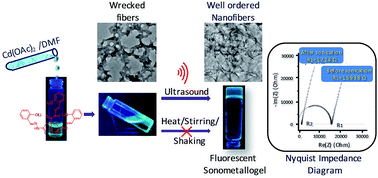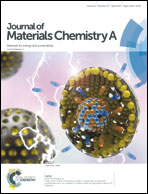A multi-stimuli responsive conductive sonometallogel: a mechanistic insight into the role of ultrasound in gelation†
Abstract
We report here the synthesis of an ultrasound induced multi-responsive fluorescent metallogel based on a non-fluorescent citric acid derived ligand (1), LiOH and Cd(OAc)2 in DMF. Ultrasound is shown to promote the de-metallation and re-complexation of Cd(II) ions proceeding through the disruption and reformation of dynamic metal–ligand coordination bonds ultimately leading to gelation. Ultrasound also proved to be responsible for the formation of uniform nanofibers (∼20 nm) as characterized by AFM and TEM studies. A deviation from the aforesaid combination in terms of the regioisomer, alkali base, transition metal ion including Zn(II), solvent and triggering effect like mechanical or heat could only produce a solution instead of a gel. The crystal structure obtained with Zn(II) analogous to metallogel constituents supports the structure involved in gelation with Cd(II). This “sonometallogel” is also found to be thermoresponsive and reversibly fluidized under suitable mechanical stress. The true gel phase material has been proved by detailed rheological studies. Another key and yet unprecedented discovery is that the sonication-induced sol–gel phase transition leads to a tenfold increase of the conductivity values.



 Please wait while we load your content...
Please wait while we load your content...